In recent years, the financial industry has witnessed a significant digital transformation with the advent of innovative technologies, including blockchain, AI, and mobile digital banking communications. Lending as a Service (LaaS) is a technological advancement that reshapes a bureaucratic and conservative landscape of credit lending services into a robust and diverse fintech ecosystem.
LaaS refers to lending services that work through cloud-based platforms, enabling financial institutions to streamline their lending operations and offer loans to customers more efficiently, with a modernized approach that goes beyond traditional methods. Cloud lending solutions provide potential lenders with the necessary technology to conduct their lending operations online.
However, LaaS is more than just a digital (i.e. web-based or mobile) loan distribution platform but an intersection of the interests between enterprises, banks, marketplaces, and regulators. The conception encompasses a comprehensive system that automates and streamlines the entire lending process. This enhanced methodology enables borrowers to access loans within minutes, revolutionizing the speed at which loans are distributed, rendered, and approved.
This article gives you an overview of LaaS technologies, their impact on the financial industry, best practices for implementation, challenges, case studies, and a glimpse into the future of this evolving type of fintech product.
If you require immediate help with the implementation of a high-end cloud lending solution into your business ecosystems and projects, make sure to contact our fintech and electronic banking specialists for consulting.
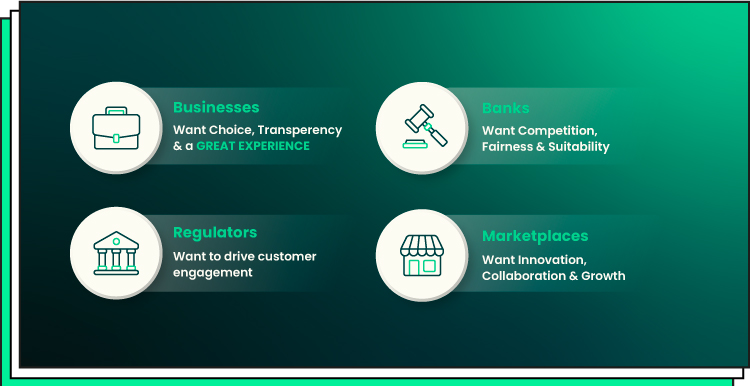
How Lending as a Service Works
Lending as a Service (LaaS), also known as Marketplace Lending, is a fintech model making waves in the global banking and finance sectors. This groundbreaking service empowers banks to expand their lending services beyond the limitations of conventional banking channels. By harnessing the potential of cutting-edge information technology, including cloud engines and Artificial Intelligence components, LaaS enables banks to make use of powerful digital platforms and their capabilities. These potential improvements include:
- Wider horizons for user accessibility
- Integration with various applications
- Implementation into mobile and web solutions
- Deeper integration of fintech tools with e-commerce platforms and AR applications, games & entertainment projects
- Implementation of ML and AI technologies into lending processes to accelerate workflows and make correct decisions.
LaaS operates within the overarching framework of Banking-as-a-Service (BaaS), a deeper concept that encompasses a wide range of modern financial services, like the utilization of Application Programming Interfaces (APIs) and cloud-based infrastructure to enable businesses to establish and manage their financial services.
LaaS can be defined as a cloud-based lending model that allows financial institutions to outsource the lending process to a third-party vendor. This domain of lending services is known as white-label lending. It offers a convenient solution for financial institutions, fintech companies, and other organizations aiming to enter or expand in the lending market. White-label lending enables clients to focus on key areas such as branding, customer acquisition, and relationship management while entrusting the lending provider with essential elements like technology, infrastructure, and regulatory compliance. The lending provider takes on various responsibilities in the lending process, including:
- Loan origination
- Eligibility check
- Underwriting
- Loan servicing
- Compliance.
They ensure that the client’s branding and user experience seamlessly integrate into the lending platform. This arrangement grants the client advantages such as a faster time to market, decreased operational costs, and the opportunity to leverage the provider’s expertise and infrastructure.
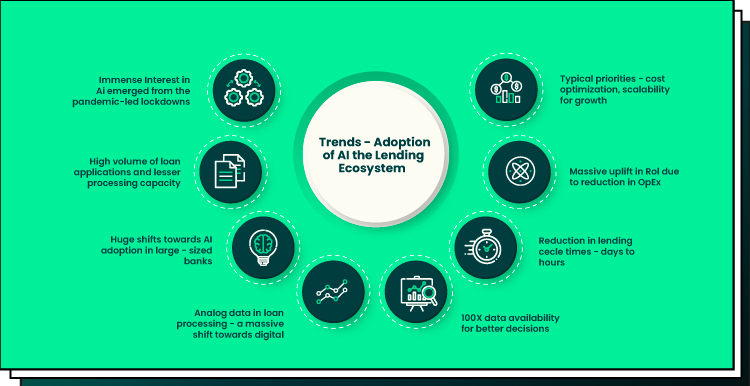
Key Benefits of LaaS and White-Label Lending Services
Have you ever made a buy-now-pay-later (BNPL) purchase at the point of sale? If positive, you’ve already encountered one of the initial widespread applications of Lending as a Service (LaaS). LaaS refers to the provision of credit lending services outside of traditional banking or lender channels and involves simplifying complex financial offerings. This makes them easily accessible through new channels and integrated experiences.
Why Is LaaS a Favorable Choice for Borrowers?
Today’s younger generation, comprised of millennials and Gen Z individuals, has been deeply affected by the lasting impact of the financial crisis that occurred between 2008 and 2009. Many of them witnessed their parents and households grappling with debt, experiencing home foreclosures, and enduring unemployment. These challenging family experiences have ingrained in them the importance of avoiding debt, whether it be from credit cards or loans, and prioritizing the establishment of a financial safety net, such as an emergency fund.
As a result, this demographic predominantly relies on debit cards for their purchases and often possesses minimal credit profiles due to limited exposure to open trade lines and insufficient payment history reported to credit bureaus. Their financial behavior and mindset have shaped a new demand among borrowers — a desire for a comprehensive range of products that offer the benefits of lending, such as increased purchasing power and the ability to establish or build their credit rating while avoiding the burden of additional debt from fees, penalties, or high annual percentage rates (APRs). This demands some sort of lending service rethinking and repositioning to make these offerings more enticing and friendlier. LaaS can come to the rescue.
Financial institutions and fintech companies that can cater to these evolving needs and provide viable alternatives stand to gain the most in terms of market share and user growth in the coming years. By recognizing and addressing the unique requirements of this borrower segment, banks, and fintech innovators can seize the opportunity to offer tailored lending solutions that align with the preferences and values of these discerning customers.
Improved Efficiency of Financial Workflows
LaaS liberates enterprises from the constraints of outdated, slow, and limited traditional banking channels. This method allows financial institutions to streamline their lending operations, considerably reducing the time and effort required for loan processing, underwriting, and servicing. By automating and digitizing various stages of the lending process, LaaS eliminates manual tasks, reduces human errors, and improves overall workflow efficiency. Financial institutions can achieve faster loan approvals, expedite fund disbursements, and enhance customer satisfaction by providing a seamless and efficient lending experience.
Scalability of Financial Services
Cloud-based lending solutions offer the flexibility to scale operations based on demand, allowing financial institutions to accommodate fluctuating loan volumes without significant infrastructure investments. This scalability is especially beneficial for financial institutions or fintech startups during peak periods of loan applications or when expanding into new markets, as they can efficiently handle increased transaction volumes without compromising performance or customer experience. Additionally, the cloud-based nature of LaaS enables seamless integration with existing systems and the ability to quickly adopt new technologies, ensuring that financial institutions can adapt to evolving customer needs and market trends.
Cost-Efficiency
One of the significant advantages of adopting LaaS is the potential for substantial cost savings. Financial institutions can minimize operational expenses by shifting away from maintaining in-house lending platforms. Instead, they can rely on the services provided by the vendor and pay only for the specific services they require. This cost-efficient approach allows institutions to allocate resources more effectively and redirect saved funds toward other strategic initiatives such as innovation, customer experience enhancements, or business expansion.
Enhanced Customer Experience
LaaS cloud platforms often provide a user-friendly interface for borrowers or customers, enabling a seamless and convenient loan application process, which is executed in a barely noticeable manner. As mentioned before, the lending event can happen at the point of sale as one of the incorporated payment options.
Customer Loyalty
By seamlessly integrating financial solutions into everyday experiences, platforms have the opportunity to not only amplify their bond with customers but also enhance overall customer loyalty. The provision of financial services within these platforms can give them a distinctive edge in an increasingly competitive market. Additionally, by offering convenient and tailored financial tools, platforms can empower customers to manage their finances more effectively.
Impact of LaaS on the Financial Industry
LaaS is revolutionizing the financial industry by transforming the delivery of lending services, which usually include no-interest loans. It represents a cutting-edge approach that fosters mutually beneficial engagement between apps, software platforms, merchants, and consumers. LaaS involves banks providing their resources and expertise to fintech companies, who then offer lending services under their own brand, often with additional technical services. The impacts of LaaS are significant:
Disrupting Traditional Lending Models
LaaS challenges the traditional brick-and-mortar lending approach by offering a compelling alternative. Through digital channels and technology-facilitated operations, financial institutions can expand their customer base, including covering underbanked populations, and provide digitalized lending services in a more accessible, enticing, and resilient manner.
Fostering Increased Competition
LaaS introduces a new wave of competition in the financial industry by encouraging the entry of innovative players like fintech startups into the lending market. This heightened competition environment attracts forward-thinking solutions, promotes tech innovation, and motivates traditional financial institutions to evolve and adapt to the changing landscape to stay relevant.
Empowering Data-Driven Decision-Making
LaaS platforms leverage the power of advanced analytics and data-driven insights to enable more accurate lending decisions. By analyzing vast amounts of data, financial institutions can assess the creditworthiness of borrowers more effectively, reducing the risk of defaults and improving the overall performance of their lending portfolios.
Unlocking Collaboration Opportunities
LaaS opens up avenues for collaboration between financial institutions and technology vendors. By tapping into the expertise of these vendors, financial institutions can offer personalized and tailored lending solutions to their customers. This collaboration enhances the value proposition of financial institutions and promotes a more customer-centric approach to lending.
Enhanced Corporate Flexibility
LaaS is reshaping financial business strategies by revolutionizing lending processes, fueling competition and agility, enabling data-driven decision-making, and fostering collaboration between key stakeholders. It paves the way for a more efficient, inclusive, and technologically advanced lending ecosystem where lending services are more fluent than ever before.
Best Practices for Implementing LaaS
LaaS (Lending as a Service) can be implemented by various entities within the financial industry. Here are four major groups of stakeholders that are potentially interested in adopting cloud-based LaaS tools and technologies. If you represent any of them and want to adopt a LaaS solution, please contact us for engineering and development.
Who Can Benefit from LaaS Solutions?
Financial Institutions
Traditional banks or lending institutions can implement LaaS by partnering with fintech companies, technology vendors, or custom software developers, like Forbytes. They provide the necessary resources, such as infrastructure, regulatory compliance, and diverse tech expertise, to enable the delivery of lending services through different digital platforms.
Fintech Companies
Fintech companies are often the driving force behind LaaS implementation. They offer their technological capabilities and innovation to develop the platforms and solutions required for delivering lending services in various contexts. Fintech companies collaborate with financial institutions to access their resources and expertise while providing the necessary technology and user experience enhancements, including branding, integration, and marketing conceptions.
Technology Vendors
Technology vendors specializing in lending solutions can also implement LaaS by offering their platforms, software, and technical services to financial institutions. These vendors develop and maintain the cloud-based infrastructure, APIs, and other tools required for seamless lending operations. They collaborate with financial institutions to customize and integrate their solutions into the existing systems.
Collaborative Partnerships
Implementation of LaaS often involves collaborative partnerships between financial institutions, fintech companies, and technology vendors, including affiliates and partners that implement lending options to their e-commerce platforms, websites, and applications. These partnerships leverage the strengths and capabilities of each party to create comprehensive and efficient lending solutions. Financial institutions contribute their industry knowledge, customer base, and lending capabilities, while fintech companies and technology vendors provide the technology, digital platforms, and specialized services, like banking gateways.
Implementing LaaS requires meticulous planning and consideration to ensure a successful integration. Here are some best practices to guide the implementation process:
Step 1: Assess Your Fintech Needs & Objectives
- Begin by clearly defining your organization’s offerings and evaluating your current lending workflows. This can include consumer credit lending, mortgage loans, scholarship and student loans, business venture loans, and more financial services.
- Identify areas where LaaS can provide the most value, such as streamlining loan origination, improving underwriting accuracy, or enhancing customer experience.
- Perform a thorough analysis to ensure that the implementation aligns with your business objectives. This assessment should take into account your target audience and their specific goals. Determine the types of loans and lending services that will provide the most value and benefit to your audience.

Step 2: Choose the Right Vendor
- Look for a vendor with a proven track record, robust infrastructure, and a comprehensive suite of lending services, which match the needs of your audience.
- Evaluate their security measures, scalability options, integration capabilities, and their compliance with regulatory standards.
- Consider their experience in your industry and their ability to meet your specific requirements.
Step 3: Ensure Seamless Integration
- Collaborate closely with the chosen vendor to ensure seamless integration of the LaaS platform with your existing systems.
- This involves mapping data flows, integrating APIs, and establishing communication protocols to ensure smooth interaction between the LaaS platform and your internal infrastructure.
- Prioritize automated processes to minimize manual intervention and reduce errors.
- Conduct thorough testing to ensure all components are working effectively.
Step 4: Data Security and Compliance
- Data security and compliance should be top priorities in LaaS implementation.
- Work closely with your vendor to ensure they have robust security measures in place, including data encryption, secure storage, and access controls.
- Ensure the vendor complies with relevant industry regulations, such as GDPR or HIPAA, depending on the nature of your lending operations.
- Regularly assess and monitor data security protocols to maintain compliance.
Step 5: Training and Сhange Management
- Provide comprehensive training to your staff to ensure a smooth transition to the new lending platform.
- Educate employees on the benefits of LaaS and how it will improve their workflows and productivity.
- Involve key stakeholders in the implementation process to gain their support and address any concerns.
- Implement a change management plan that includes clear communication, training sessions, and ongoing support to help employees adapt to the new system.
- By following these best practices, you can ensure a successful implementation of LaaS, optimize your lending processes, and drive positive outcomes for your organization.
Here are a few examples of fintech platforms and services:
- Ezbob in the U.K.
- Synctera and Stripe in the United States and Canada
- Wallester in the E.U.
Additionally, there are niche-focused lending services such as:
- Roostify for home loans
- Ernest for student and scholarship loans
- Built for constructional subcontractors
- Reggora for mortgage appraisal services.
It’s important to note that these examples are provided for illustrative purposes only, and we do not endorse or recommend any specific platform or service. These or other services of your choice can be implemented or integrated with your fintech solutions, please contact us for free consulting. See more LaaS and BaaS fintech services in this picture:
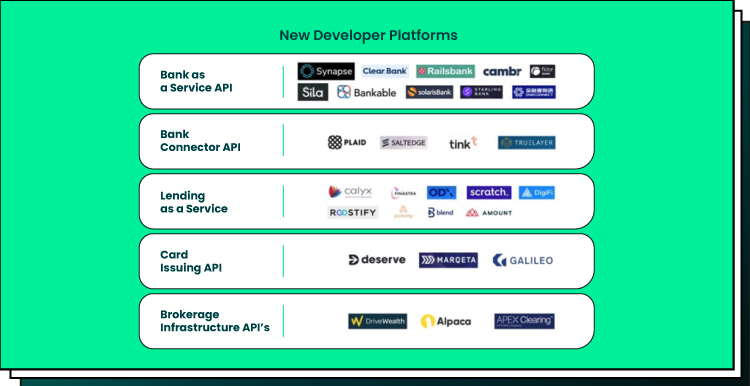
Challenges Associated with LaaS
While LaaS brings a multitude of benefits, there are several challenges that need to be addressed during implementation:
Data Privacy and Security
When outsourcing lending operations, ensuring the protection of sensitive data requires additional attention. Financial institutions must carefully assess the security measures and protocols of the chosen vendor to safeguard customer information and comply with applicable data protection regulations.
Integration Complexities
Integrating a new lending platform with existing systems can be a complex process. It requires accurate IT environment auditing, testing, data synchronization, and seamless integration to ensure smooth operations and a seamless customer experience.
Vendor Selection
Selecting the right LaaS vendor is critical to the success of the implementation. Financial institutions should consider factors such as the vendor’s industry expertise, reputation, infrastructure capabilities, scalability options, and ability to tailor solutions to meet specific business requirements. A thorough evaluation and due diligence process should be conducted before finalizing the vendor partnership.
Addressing these challenges proactively and ensuring proper planning and execution can help financial institutions maximize the benefits of LaaS while mitigating potential risks and ensuring a successful implementation.
Impact of LaaS and AI on Financial Business Outcomes
These case studies exemplify the positive outcomes resulting from the adoption of LaaS by financial institutions. By the utilization of technology-driven lending solutions, banks and credit unions can enhance their bureaucratic processes, elevate customer satisfaction, and fuel expansion within their loan portfolios. The given examples are conceptual cases yet typical, so they can be easily replicated with your specific company through the integration of LaaS platforms and other fintech solutions.
AI-Enhanced LaaS Development for Successful Digital Banking: Personalized Lending Services
AI technology can be implemented with a lending service provider platform, like a private bank, in order to yield significant benefits through the following fintech technologies:
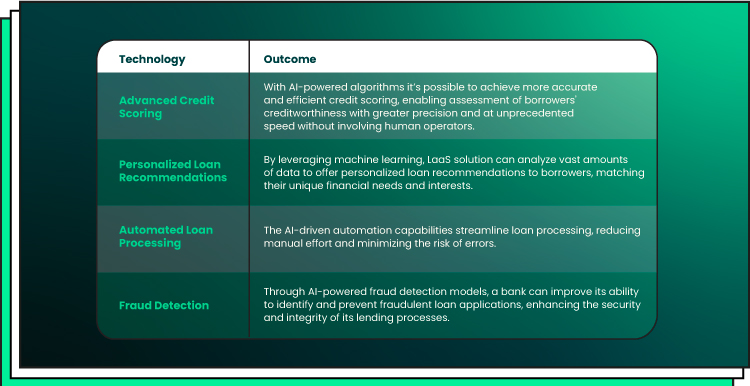
Credit Union Adopts Cloud LaaS Solutions to Modernize Lending Operations
By utilizing the LaaS vendor’s advanced platform, a credit union can achieve the following outcomes and improvements:
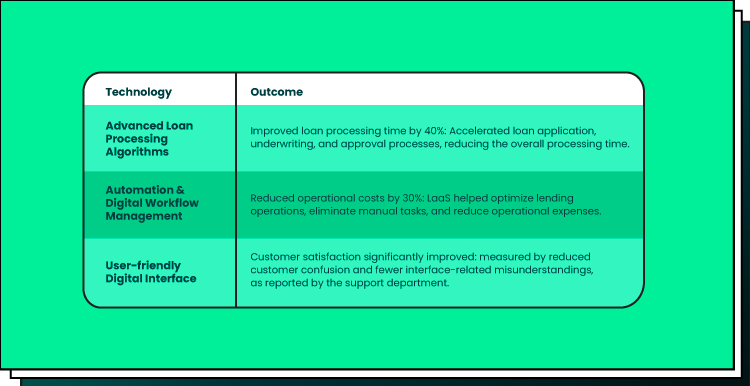
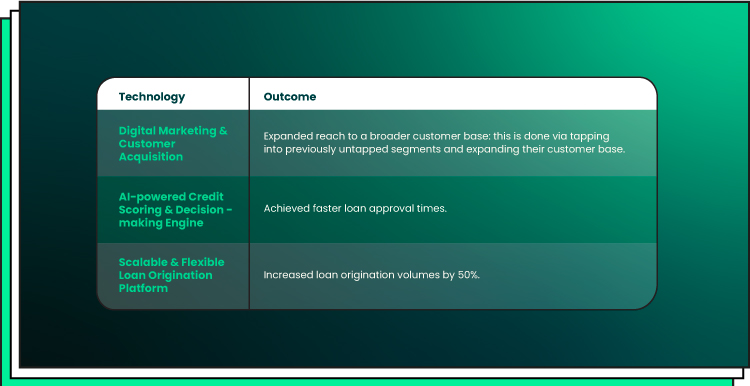
Conclusion on Building LaaS Fintech Solutions
In today’s rapidly changing financial landscape, Lending as a Service (LaaS) has emerged as a game-changer, redefining how lending is done. By harnessing the power of LaaS, financial institutions can unlock a world of possibilities and drive their businesses to new heights.
With LaaS, financial institutions can streamline lending processes, reduce operational costs, and tap into a wider customer base. Don’t miss out on the opportunity to revolutionize your lending processes. Take the leap with Forbytes and discover the transformative power of LaaS.
Contact us today to learn more about our fintech development services and how we can help drive your business forward.

Our Engineers
Can Help
Are you ready to discover all benefits of running a business in the digital era?

Our Engineers
Can Help
Are you ready to discover all benefits of running a business in the digital era?






